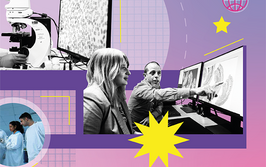Preparing for the Worst of Us
Patient prejudices do exist, but with the right preparation – for them and us – we can sidestep discrimination to do what we do best: save lives
Should I start with the numbers?
Would it surprise you to know that 26 percent of practicing physicians in the United States were trained in other countries (1)? That foreign-born doctors, representing over 40 percent of our primary care workforce and over half of the doctors in elder care, are responsible for treating our most vulnerable citizens (2)? You may also be interested to know that patients are less likely to die within 30 days if their physician is from another country – either 0.5 or 5 percent less likely, depending on your source (3).
Or maybe you’d rather hear a story…
How about the time I was in residence in pathology at Georgetown University, at our fine needle aspiration clinic, treating a patient with a lump in her neck? After she found out that I was from Saudi Arabia and my attending was from Syria, she said, “Oh, great. I’m stuck between two people from terrorist countries.”
The problem is that, although the numbers we deal with are rational and don’t hold biases, our patients do. Although foreign-born and internationally trained doctors represent a large percentage of the US healthcare practitioners and perform at least as well as our domestic colleagues, we are often subjected to xenophobic comments and rejected by American patients because of their own background.
About 15 percent of pediatric residents report that they’ve heard prejudicial comments from patients (4). Doctors may be more likely to hear these comments in rural communities where these biases are common, but the problem is found in urban environments as well: roughly 40 percent of physicians at a New York-area hospital report having witnessed patients rejecting doctors based on race or ethnicity (4). So what does that mean for the huge population of people moving to the United States to work in medicine? Well, it means that they need to prepare for patients who – despite evidence; despite facts; despite rational thinking – are convinced that these doctors are less competent than their American counterparts. I think the best approach to address this challenge is through four main points:
- Discussion. In our residency teaching conferences, we focus a lot on sharing scientific knowledge – but perhaps not enough on how stereotyping affects interactions in the clinic and in the lab. This new era of precision medicine will require pathologists to face more patients, so we need to be ready.
- Simulations.Diversity training would be a valuable addition to any medical institution – not in the usual common-sense context, but instead training doctors in how to respond to patients who reject commonly held values of diversity and inclusion. To respond firmly – yet gracefully – to such patients, we’ll have to practice.
- Formal introductions. These patients may react strongly in part because they are shocked when someone so different from them is thrust into their personal space, especially while they are in a vulnerable position. If patients are informed beforehand that their doctor is from a different country, they may have more time to process this information and prepare for the interaction.
- Biographical statements. Patients in the United States need to be reminded that, no matter what country their doctor is from, he or she is a well-trained professional. A full biographical statement detailing the physician’s training background may reinforce that their doctor is fully capable of treating them.
Perhaps we cannot change these patients’ behavior – we certainly don’t have enough time to change their deeply held prejudices – but we can help our physicians navigate these stressful situations better. And maybe, just maybe, we can help patients get out of their own way so we can save their lives.
- PD Ranasinghe, “International medical graduates in the US physician workforce”, 115, 236–241 (2015).
- The New York Times, “Why America needs foreign medical graduates”, (2017). Available at: nyti.ms/2jFK6ev. Accessed May 8, 2018.
- Reuters, “U.S. patients have lower mortality rates with foreign-trained doctors”, (2017). Available at: reut.rs/2K2JHOx. Accessed May 8, 2018.
- CNN, “Racism in medicine: an ‘open secret’”, (2016). Available at: cnn.it/2rst7kh. Accessed May 8, 2018.
Malak Abedalthagafi is Assistant Research Professor of Genomic and Neuropathology at King Abdulaziz City for Science and Technology, Consultant Physician in Molecular Genetics and Neuropathology at King Fahad Medical City, Saudi Arabia, and part-time faculty member at Harvard Medical School, USA.




















